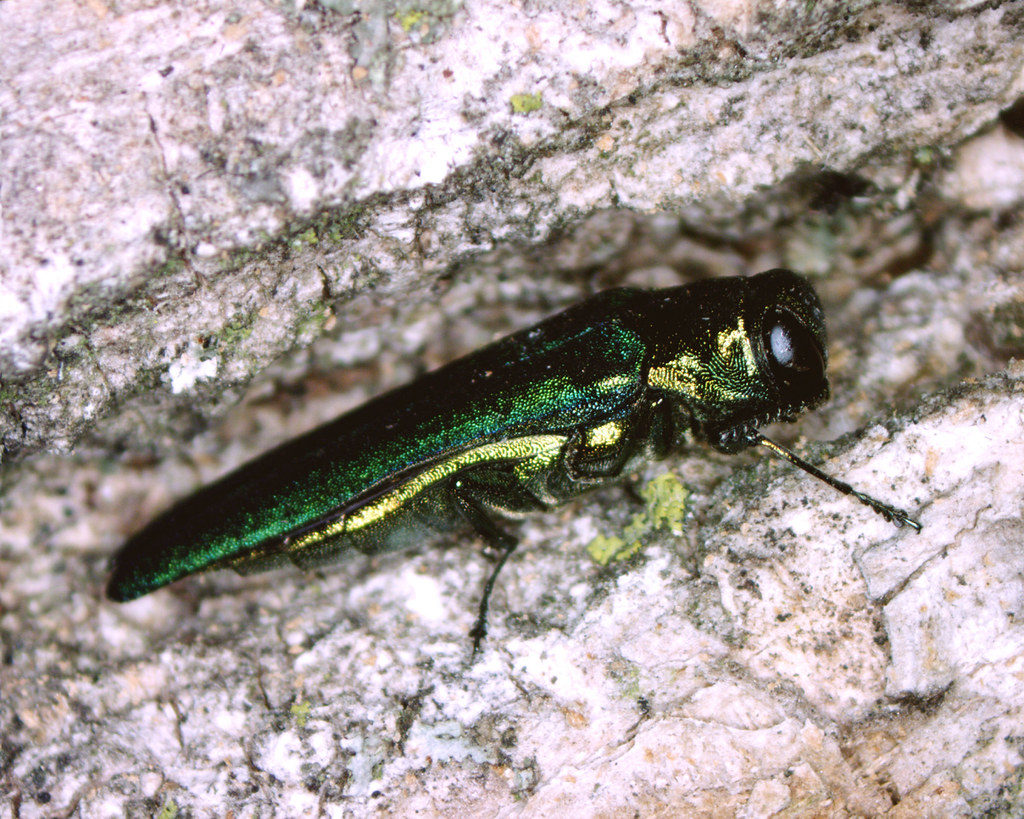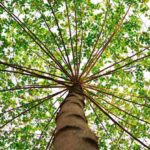
Instead of blood pressure, heart rate, and cholesterol levels, your tree’s yearly physical is all about checking for — and preventing — disease and decay in the roots, trunk, branches, and leaves. Giving your trees a checkup will help determine which ones are healthy, which need treatment, and which are so hazardous they must be removed. Here’s how to give your tree a checkup on your own.
What Makes a Tree Healthy?
The Montana State University Extension says distinguishing healthy trees from not-so-healthy ones is all in the appearance of the crown. Healthy trees boast at least one-third of their height in leaves or needles, maintain a symmetrical look, and display a dense canopy of properly colored leaves, as is normal for their type.
To maintain their health, trees need ample sunlight, oxygen, nutrients, water, and growing space. Without these, photosynthesis (the process in which plants use sunlight, water, and carbon dioxide to make food) can’t take place.
Avoiding tree stress and soil compaction, as well as regular trimming and pruning, is also key. Stress can weaken a tree, making it susceptible to disease, and soil compaction hinders roots from getting the necessary nutrients.
“If [the crown is] sparse, or if the needles are off-color, that’s showing us that the tree’s not getting all the nutrients it needs, and it could be a sign of some sort of health issue,” says Nichole Strong, an Oregon State University extension forester.
How to Give a Tree a Checkup
The Arbor Day Foundation suggests spring as the perfect time to check on your young and mature trees. Since this is when the trees sprout new leaves, you’ll be better able to notice any issues with canopies and structure. The spring checkup will also alert you to any storm damage suffered during the previous winter. Catching problems early will not only save your trees, but it can also prevent falling trees from destroying your property, or worse, injuring someone.
Before jumping into an analysis of specific tree parts, it’s a good idea to take a look at the trees in your yard as a whole. How do they look compared to one another? Are there trees that should be spouting leaves, but are still bare? What about discoloration or abnormal growth?
Jot down a list of potential problems, and then, upon closer examination, you can determine if there’s an issue.
1. Assess the roots

Check for weak roots when giving your tree a checkup
The foundation of any tree’s life is its roots. Not only do they carry water, oxygen, and nutrients to all parts of a tree, they also keep it firmly planted in the ground. If roots become damaged or stressed, whether from construction, disease, or other plants competing for food, the life of the tree is at risk.
Signs of potential root problems to look for include yellowing leaf tissue (chlorotic foliage), stunted growth, branch dieback, and mushroom growth at or near the base of the trunk. “Root decay cannot be reversed or corrected, and its presence causes a tree to be less physically stable,” according to the University of Georgia Extension. “If its root system is compromised, the tree will decline, or even worse, fall.”
2. Evaluate the trunk
If you spot large bumps or bulges, lichens, wetwood, or other non-harmful tree conditions, there’s no need to worry. But sizeable holes, cracks, and other wounds, such as missing bark in the tree trunk can lead to interior decay and the death of the tree.
Oozing bark, a flat-sided or leaning trunk, soil disruption, damaged root flare, and insect pests may also be signs of potential problems.
Another way to determine the health of your trees by their trunks is to measure the circumference for growth. After the initial year, check growth annually with a tape measure. If trunks show an increase of 2 centimeters or more, they’re healthy. If there’s less growth, this may signal an issue with a tree’s root system.
3. Check the branches and leaves
 Dead tree branches and needles
Dead tree branches and needles
Branches that are bare, broken or loose, showing no signs of growth, covered in fungus, or growing downward are signs your tree may be diseased or have structural problems. Removing these by pruning and trimming as soon as possible may save the tree. There’s also a possibility the tree has a more serious issue.
“Dead branches that are all on one side of a tree can be a symptom of root or trunk damage on the affected side,” according to horticulturists at the University of Maryland Extension. Root damage cannot be fixed, and if the tree is in the way of people, homes, or other buildings, it will need to be removed.
As for the leaves, be sure to check for discoloration, unusual shape, insect damage, and unseasonable shedding.
Give Your Tree a Checkup for Insects
Six insects wreak the most havoc on trees. As you take stock of potential issues during your tree health checkup, include a check for these insects while examining leaves, branches, and tree trunks.
1. Asian longhorned beetles

Photo by USDA / CC-BY-2.0
Native to China, these Asian longhorned beetles are about an inch long and have a shiny, black body. The larvae live under tree bark and feed on the tree’s living tissues, while adult beetles devour leaves and twigs. If not found and treated, Asian longhorned beetles will damage a tree’s vascular system, and eventually kill it.
Asian longhorned beetles typically infect maple trees, elms, birches, horse chestnuts, black locusts, willows, poplars, and green ash.
2. Emerald ash borers

Emerald ash borer / CC By-ND 2.0
Bright, metallic green as their name suggests, emerald ash borers feed on ash trees, killing millions each year. Signs of infestation include D-shaped holes and S-shaped tunnels in bark, wilting leaves, thinning canopies, and branch dieback. If your trees are infested with these pests, you may have no choice but to cut them down and replace them with another species. Give your tree a checkup to limit the spread of these insects.
3. Japanese beetles

Japanse beetles Photo by Ryan Hodnett / CC BY-SA
These pests aren’t finicky when it comes to types of trees to attack. Japanese beetles will dine on more than 300 species of trees, shrubs, flowers, and grass.
The telltale sign of Japanese beetle activity on trees is skeletonized leaves. Fortunately, this damage is usually cosmetic.
4. Asian citrus psyllids

Asian citrus psyllid / David Hall / USDA
Not only do Asian citrus psyllids damage citrus trees by indulging in their sap, they also transmit citrus greening disease as they feed. This bacterial infection shortens a tree’s lifespan and reduces quality fruit production.
5. Whiteflies

Whiteflies Photo / CSIRO / CC BY 3.0
Whiteflies also feed on tree sap, particularly from the living tissues in leaves and stems. If whiteflies are present, leaves may show discoloration, dry out, and fall off. Most of the time, these pests don’t harm the tree’s health.
6. Hemlock wooly adelgids

Hemlock wooly adelgids / Beatriz Moisset / CC BY-SA 4.0
Active during the winter months, hemlock wooly adelgids form white, cotton ball-like or “wooly” structures on the limbs of hemlock trees. These structures are built to protect adult adelgids and their eggs.
Both adults and their offspring feed on the tree’s needles, causing the needles to dry up and fall off. This also prevents new buds from growing.
When to Call a Pest Control Expert
After going through this checklist on your own, take pictures of potential damage to send to a certified arborist. When the pros come out to inspect your trees further, they’ll be able to identify sources of problems and guide you on ways to rehabilitate your tree, if possible.
These arborists can prune and trim branches, cable and brace trunks, and, if the tree has already become a hazard, they can set up an appointment for safe tree removal.
Maintaining the trees in your landscape requires regular care and maintenance. Follow these tips, and you’ll have an outdoor space that’s beautiful, healthy, and safe for all involved.


![10 Best Chainsaws for the Money in 2022 [Reviews]](https://www.lawnstarter.com/blog/wp-content/uploads/2021/02/Best-Chainsaws-for-the-Money-150x150.jpg)



